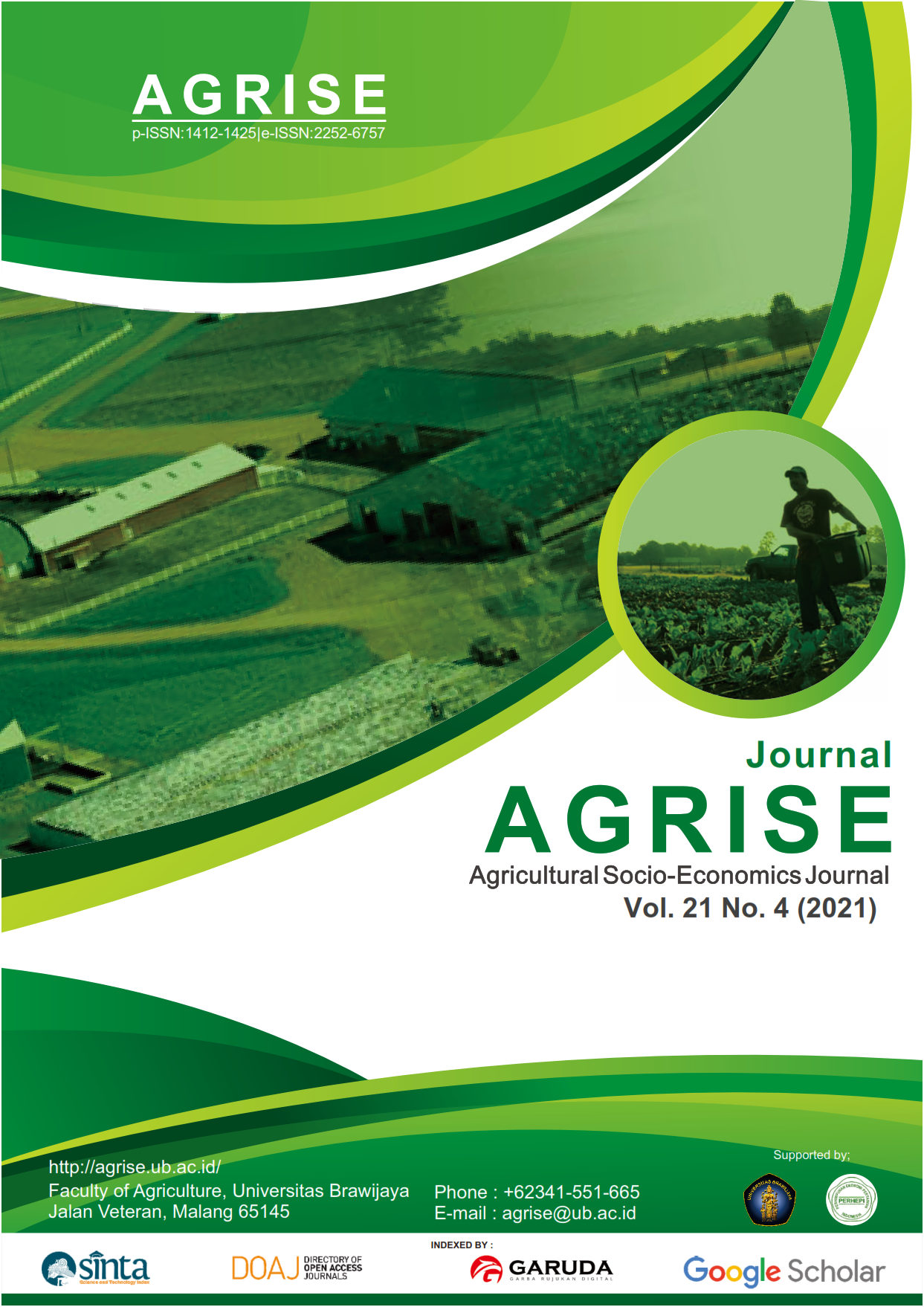TECHNICAL EFFICIENCY OF ORGANIC RICE IN SUMBERNGEPOH VILLAGE, LAWANG SUB DISTRICT, MALANG DISTRICT
DOI:
https://doi.org/10.21776/ub.agrise.2020.021.4.7Keywords:
Organic, Rice, DEA, Technical efficiency, AgricultureAbstract
Rice plants have a proportion of 6 percent or fifth in the world's classification of organic cereal crops (Research Institute of Organic Agriculture, 2017). The problem in organic rice farming is that production and productivity tend to be lower than those of non-organic rice. In addition to the transition from agriculture to organic farming, the factor of input use also has a big influence. This study aims to analyze the level of technical efficiency and the value of organic rice input. The census sample consisted of 45 organic rice farmers. The data used is data in the 2016-2017 rainy season. The data analysis method uses DEA analysis with the assumption of CRS Input. Based on the results of the analysis, farmers are not yet technically efficient because they have an average technical efficiency value of less than 1, which is 0.879. The number of technically efficient farmers with a TE value of 1 is 13 farmers, while the number of farmers who are inefficient is 32 farmers with a TE value of <1. There are slack values such as seeds 3.15 Kg/Ha, solid organic fertilizer 276.58 Kg/Ha, liquid organic fertilizer 1.07 L/Ha, green manure 505.10 Kg/Ha, vegetable pesticides 1.25 L/Ha, and 6.67 daily workers/ha. In addition, there are projected input values, namely seeds 28.66 Kg/Ha, solid organic fertilizer 2170.30 Kg/Ha, liquid organic fertilizer 10.23 L/Ha, green manure 7048.76 Kg/Ha, vegetable pesticides 9.61 L /Ha, and Labor 185.80 daily workers/Ha. Furthermore, the projected value of this input is a recommendation to farmers so that they can be technically efficient.
References
Cooper, W. W., Deng, H., Huang, Z., & Li, S. X. (2002). Chance constrained programming approaches to technical efficiencies and inefficiencies in stochastic data envelopment analysis. Journal of the Operational Research Society, 53(12), 1347–1356. https://doi.org/10.1057/palgrave.jors.2601433
Elfman, L., Tooke, N. E., & Patring, J. D. M. (2011). Detection of pesticides used in rice cultivation in streams on the island of Leyte in the Philippines. In Agricultural Water Management (Vol. 101, Issue 1, pp. 81–87). https://doi.org/10.1016/j.agwat.2011.09.005
Endri, E. (2017). EFISIENSI TEKNIS PERBANKAN SYARIAH DI INDONESIA. Jurnal Keuangan Dan Perbankan; Vol 10 No 2 (2008): Vol.10 No. 2 December 2008. http://journal.perbanas.id/index.php/jkp/article/view/148
Farrell, M. J. (1957). The Measurement of Productive Efficiency. Journal of the Royal Statistical Society: Series A (General), 120(3), 253–281. https://doi.org/https://doi.org/10.2307/2343100
IFOAM - Organics International. (2005). Definition of Organic Agriculture | IFOAM. In 2008. https://www.ifoam.bio/why-organic/organic-landmarks/definition-organic%0Ahttps://www.ifoam.bio/why-organic/organic-landmarks/definition-organic%0Ahttps://www.ifoam.bio/en/organic-landmarks/definition-organic-agriculture
Research Institute of Organic Agriculture. (2017). No Title. https://www.fibl.org/en/index.html
Sullivan, P. (2003). Organic Rice Production. Appropriate Technology Transfer for Rural Areas, April, 1–6. https://attra.ncat.org/attra-pub/download.php?id=91%5Cn
Downloads
Published
How to Cite
Issue
Section
License
Authors who publish with this journal agree to the following terms:
- Authors retain copyright and grant the journal right of first publication with the work simultaneously licensed under a Creative Commons Attribution-NonCommercial License that allows others to share the work with an acknowledgment of the work's authorship and initial publication in this journal.
- Authors are able to enter into separate, additional contractual arrangements for the non-exclusive distribution of the journal's published version of the work (e.g., post it to an institutional repository or publish it in a book), with an acknowledgment of its initial publication in this journal.
- Authors are permitted and encouraged to post their work online (e.g., in institutional repositories or on their website) prior to and during the submission process, as it can lead to productive exchanges, as well as earlier and greater citation of published work (See The Effect of Open Access).











